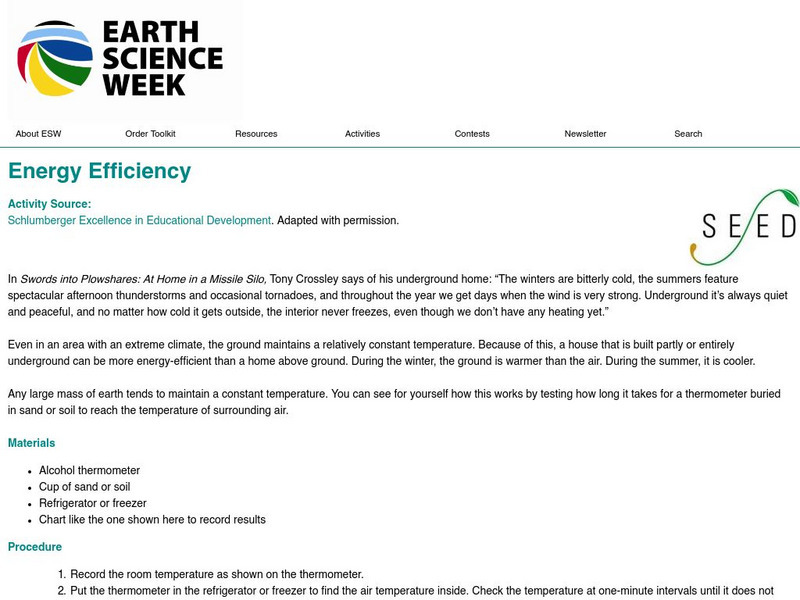Hi, what do you want to do?
American Geosciences Institute
American Geosciences Institute: Earth Science Week: Energy Efficiency
In this simple experiment, students learn about the insulating characteristics of soil and how this relates to energy efficiency.
Physics Aviary
Physics Aviary: Read the Thermometer Challenge
Checks your ability to read thermometers.
Lawrence Berkeley National Laboratory
Berkeley Lab: Phases of Nuclear Matter
A brief explanation of determining the temperature and density at which the critical point of nuclear matter is located.
Physics Aviary
Physics Aviary: Ideal Engine Lab
This lab is designed to have students examine how the temperature of the heat source and the temperature of the coolant effect the efficiency of the ideal engine.
Teachers.net
Teachers.net Lesson: Weather
Here are several great lesson ideas for a weather unit. The lessons cover topics in math and science including making clouds, recreating the water cycle, and making a tornado. There is also a list of weather resources for more information.
Exploratorium
Exploratorium: Science Snacks: Hand Held Heat Engine
Can you defy the force of gravity by making liquid in a toy rise and fall without turning it over? This experiment will show you how to use hand boiler that uses temperature and pressure to move liquid into the top chamber.
American Geosciences Institute
American Geosciences Institute: Earth Science Week: Your Own Greenhouse
Climate scientists around the world study greenhouse gases and the ways they affect global climate. By making a small greenhouse, recreate the greenhouse effect and measure its effect on temperature.
BBC
Bbc: Gcse Bitesize: Enxymes
This lesson focuses on enzyme-catalysed reactions and the effect of temperature, substrate concentration, and pH on the reaction rate. It provides a link to an assessment.
BBC
Bbc: Gcse Bitesize: Adaptations Adaptations, Interdependence and Competition
Organisms depend on each other for survival. This is called interdependence. Both living and non-living factors will affect the abundance and distribution of organisms in a habitat. Included is a link to a test.
Science Struck
Science Struck: Limiting Factors in the Desert Ecosystem
Describes conditions in a desert that limit how large populations of species can grow.
Science Struck
Science Struck: Working of an Infrared Thermometer
Learn how an infrared thermometer works and what each of its parts does. A chart lists the different applications of infrared thermometers by the wavelength each emits.
Other
National Physical Laboratory: The History of Length Measurement
This resource provides historic information on length measurement in the United Kingdom. Click on the topics on the left toolbar of the article to find out more information.
Other
Water on the Web: Studying Heat Budgets of Lakes
Interesting activity that discusses many aspects of the energy in a lake, including the evaporation of the water into gas.
Concord Consortium
Concord Consortium: Phase Change
In this activity, students explore phase change at a molecular level. (Requires Java)
Concord Consortium
Concord Consortium: Gas Laws
In this activity, students study gas laws at a molecular level.
Other
Science Alive: Melting Point Simulation
Percy Julian and Josef Pikl used the fact that melting point-the temperature at which a substance changes from a solid to a liquid-is a characteristic property of a substance to prove that the British chemist Robert Robinson could not...
University Corporation for Atmospheric Research
Ucar: The Ideal Gas Law
The Ideal Gas Law describes how pressure, temperature, density, and volume are related to each other and helps us explain how weather works.
University Corporation for Atmospheric Research
Ucar: What Is Weather?
Rain and dull clouds, windy blue skies, cold snow, and sticky heat? This site helps students learn more about weather and what causes it to change.
The Franklin Institute
Franklin Institute Online: Keep Your Own Weather Journal
This site, which is provided for by the Franklin Institute Online, gives a format for keeping a weather journal.
Other
Metamorphic Rocks [Ppt]
Explains the different ways that metamorphic rocks can form. Looks at high temperature, high pressure, and chemically active fluids. Discusses structures created in metamorphic rocks by different forces and the classifications based on...
University of St. Andrews (UK)
University of St. Andrews: Climate and Weather Systems
This online lecture covers topics of air pressure, density and temperature.
The Wonder of Science
The Wonder of Science: Ms Ps3 4: Thermal Energy Transfer
Work samples, phenomena, assessment templates, and videos that directly address standard MS-PS3-4: thermal energy transfer.
NC State University
Ncsu.edu: Adventures of the Agronauts
This site is an online science curriculum on how to grow plants on the Moon. There are six lessons that have a glossary also included. There are movies that demonstrate concepts, and teacher resources. The sites topics cover, the Earth,...
CK-12 Foundation
Ck 12: Physical Science: Thermal Energy
[Free Registration/Login may be required to access all resource tools.] What thermal energy is and how it relates to temperature and mass.

















